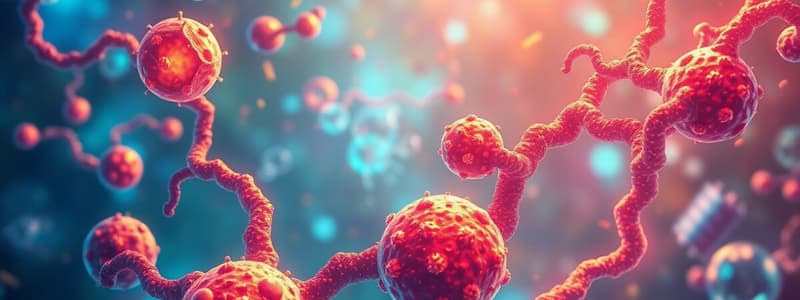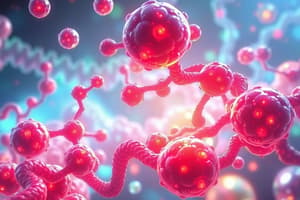Podcast
Questions and Answers
What is the correct definition of anabolism?
What is the correct definition of anabolism?
- The process of energy release during cellular respiration
- Transport of nutrients across cell membranes
- Synthesis of larger molecules from smaller ones (correct)
- Degradation of larger molecules into smaller ones
Which statement accurately describes enzyme activity?
Which statement accurately describes enzyme activity?
- Enzymes can lower the activation energy required for a reaction. (correct)
- Enzymes are permanently changed after the reactions.
- Enzymes become integrated into the reaction products.
- Enzymes are only effective at high temperature ranges.
Which of the following best describes the role of ATP in cells?
Which of the following best describes the role of ATP in cells?
- ATP is mainly involved in storing genetic information.
- ATP acts as a structural component of cell membranes.
- ATP serves as the energy currency of the cell. (correct)
- ATP is primarily used for synthesizing proteins.
What is the primary effect of temperature on enzyme activity?
What is the primary effect of temperature on enzyme activity?
In biological oxidation-reduction reactions, what occurs during oxidation?
In biological oxidation-reduction reactions, what occurs during oxidation?
How do enzymes interact with their substrates?
How do enzymes interact with their substrates?
Which source of energy is associated with molecular motion?
Which source of energy is associated with molecular motion?
Which of the following statements is NOT true about enzymes?
Which of the following statements is NOT true about enzymes?
What is the primary purpose of glycolysis in cellular respiration?
What is the primary purpose of glycolysis in cellular respiration?
Where does the Krebs cycle occur within the cell?
Where does the Krebs cycle occur within the cell?
After glycolysis, what is the next molecule produced that enters the Krebs cycle?
After glycolysis, what is the next molecule produced that enters the Krebs cycle?
How many ATP molecules are produced during the Krebs cycle for each molecule of acetyl-CoA that enters?
How many ATP molecules are produced during the Krebs cycle for each molecule of acetyl-CoA that enters?
What is the main function of the electron transport chain in aerobic respiration?
What is the main function of the electron transport chain in aerobic respiration?
What is produced during lactic acid fermentation?
What is produced during lactic acid fermentation?
What is the net gain of ATP from glycolysis?
What is the net gain of ATP from glycolysis?
Which molecule can serve as an alternative electron acceptor during anaerobic respiration?
Which molecule can serve as an alternative electron acceptor during anaerobic respiration?
What is a key difference between aerobic and anaerobic respiration in terms of ATP production?
What is a key difference between aerobic and anaerobic respiration in terms of ATP production?
What is the final electron acceptor in aerobic respiration?
What is the final electron acceptor in aerobic respiration?
During alcoholic fermentation, what are the end products?
During alcoholic fermentation, what are the end products?
What is generated as a waste product during the Krebs cycle?
What is generated as a waste product during the Krebs cycle?
In which phase of glycolysis is glucose phosphorylated to form fructose-1,6-bisphosphate?
In which phase of glycolysis is glucose phosphorylated to form fructose-1,6-bisphosphate?
Why is fermentation important for cells in anaerobic conditions?
Why is fermentation important for cells in anaerobic conditions?
What defines the process of catabolism in metabolism?
What defines the process of catabolism in metabolism?
What role do cofactors play in enzyme function?
What role do cofactors play in enzyme function?
How do enzymes achieve lower activation energy in chemical reactions?
How do enzymes achieve lower activation energy in chemical reactions?
What is a characteristic feature of ATP that allows it to serve as the energy currency of the cell?
What is a characteristic feature of ATP that allows it to serve as the energy currency of the cell?
Which of the following best describes the relationship between oxidation and reduction reactions?
Which of the following best describes the relationship between oxidation and reduction reactions?
Which of the following statements accurately describes the characteristics of enzymes?
Which of the following statements accurately describes the characteristics of enzymes?
Which form of energy is directly associated with the movement of electrons?
Which form of energy is directly associated with the movement of electrons?
What is one of the primary functions of enzymes in biological systems?
What is one of the primary functions of enzymes in biological systems?
What is the primary purpose of the Krebs cycle during cellular respiration?
What is the primary purpose of the Krebs cycle during cellular respiration?
During glycolysis, which molecule is broken down into pyruvate?
During glycolysis, which molecule is broken down into pyruvate?
What are the end products of lactic acid fermentation?
What are the end products of lactic acid fermentation?
Which step in the Krebs cycle produces ATP or GTP?
Which step in the Krebs cycle produces ATP or GTP?
What occurs in the mitochondrial matrix during cellular respiration?
What occurs in the mitochondrial matrix during cellular respiration?
What role do NADH and FADH₂ play in the electron transport chain?
What role do NADH and FADH₂ play in the electron transport chain?
In anaerobic respiration, what is the primary purpose of fermentation?
In anaerobic respiration, what is the primary purpose of fermentation?
How many molecules of ATP are typically produced from one molecule of glucose through aerobic respiration?
How many molecules of ATP are typically produced from one molecule of glucose through aerobic respiration?
What substance is produced as a waste product during the Krebs cycle?
What substance is produced as a waste product during the Krebs cycle?
What is the function of acetyl-CoA in cellular respiration?
What is the function of acetyl-CoA in cellular respiration?
How does alcoholic fermentation contribute to biotechnology?
How does alcoholic fermentation contribute to biotechnology?
In which phase of the Krebs cycle is citric acid formed?
In which phase of the Krebs cycle is citric acid formed?
What is the link between the electron transport chain and oxidative phosphorylation?
What is the link between the electron transport chain and oxidative phosphorylation?
Flashcards
Metabolism
Metabolism
The sum of all chemical reactions in a cell.
Anabolism
Anabolism
The building-up of larger molecules from smaller ones; biosynthesis.
Catabolism
Catabolism
The breaking-down of large molecules into smaller ones, often releasing energy.
Enzyme
Enzyme
Signup and view all the flashcards
Enzyme Structure/substrate interaction
Enzyme Structure/substrate interaction
Signup and view all the flashcards
Activation Energy
Activation Energy
Signup and view all the flashcards
ATP
ATP
Signup and view all the flashcards
Oxidation/Reduction
Oxidation/Reduction
Signup and view all the flashcards
Aerobic Respiration
Aerobic Respiration
Signup and view all the flashcards
Glycolysis
Glycolysis
Signup and view all the flashcards
Pyruvate Decarboxylation
Pyruvate Decarboxylation
Signup and view all the flashcards
Krebs Cycle
Krebs Cycle
Signup and view all the flashcards
Electron Transport Chain
Electron Transport Chain
Signup and view all the flashcards
Oxidative Phosphorylation
Oxidative Phosphorylation
Signup and view all the flashcards
Anaerobic Respiration
Anaerobic Respiration
Signup and view all the flashcards
Fermentation
Fermentation
Signup and view all the flashcards
Lactic Acid Fermentation
Lactic Acid Fermentation
Signup and view all the flashcards
Alcoholic Fermentation
Alcoholic Fermentation
Signup and view all the flashcards
Photosynthesis
Photosynthesis
Signup and view all the flashcards
Light-Dependent Reactions
Light-Dependent Reactions
Signup and view all the flashcards
Light-Independent Reactions (Calvin Cycle)
Light-Independent Reactions (Calvin Cycle)
Signup and view all the flashcards
Chlorophyll
Chlorophyll
Signup and view all the flashcards
Carbon Fixation
Carbon Fixation
Signup and view all the flashcards
Lowering Activation Energy
Lowering Activation Energy
Signup and view all the flashcards
Energy Sources
Energy Sources
Signup and view all the flashcards
Redox Reactions
Redox Reactions
Signup and view all the flashcards
ATP (Adenosine Triphosphate)
ATP (Adenosine Triphosphate)
Signup and view all the flashcards
Where does glycolysis occur?
Where does glycolysis occur?
Signup and view all the flashcards
What does glycolysis produce?
What does glycolysis produce?
Signup and view all the flashcards
What is the input for glycolysis?
What is the input for glycolysis?
Signup and view all the flashcards
How is the Krebs cycle linked to glycolysis?
How is the Krebs cycle linked to glycolysis?
Signup and view all the flashcards
What is the purpose of the Krebs cycle?
What is the purpose of the Krebs cycle?
Signup and view all the flashcards
Where does the Krebs cycle occur?
Where does the Krebs cycle occur?
Signup and view all the flashcards
What is oxidative phosphorylation?
What is oxidative phosphorylation?
Signup and view all the flashcards
What is the role of oxygen in aerobic respiration?
What is the role of oxygen in aerobic respiration?
Signup and view all the flashcards
How much ATP is produced in aerobic respiration?
How much ATP is produced in aerobic respiration?
Signup and view all the flashcards
What happens to pyruvate in anaerobic respiration?
What happens to pyruvate in anaerobic respiration?
Signup and view all the flashcards
How does fermentation differ from aerobic respiration?
How does fermentation differ from aerobic respiration?
Signup and view all the flashcards
What are some examples of fermentation products?
What are some examples of fermentation products?
Signup and view all the flashcards
What is the role of NAD⁺ in fermentation?
What is the role of NAD⁺ in fermentation?
Signup and view all the flashcards
What is the purpose of photosynthesis?
What is the purpose of photosynthesis?
Signup and view all the flashcards
Why is photosynthesis important for the energetics of life?
Why is photosynthesis important for the energetics of life?
Signup and view all the flashcards
Study Notes
Metabolism
- Metabolism encompasses all the chemical reactions within a cell.
- Two types:
- Anabolism (Biosynthesis): Builds larger molecules from smaller ones, forming cell structures.
- Catabolism: Degrades larger molecules into smaller ones, usually releasing energy.
Enzymes
- Enzymes are protein catalysts that accelerate metabolic reactions.
- They are not consumed or changed by the reaction.
- They have an active site for substrates.
- They lower the activation energy, the energy required to start a reaction.
- Enzyme activity is greatly affected by temperature and pH.
- They require cofactors (non-protein components) for some functions.
Energy Sources and Transfer
- Cells utilize various energy forms: thermal (heat), radiant, electrical, mechanical, atomic, and chemical (energy stored in molecular bonds).
- Oxidation-reduction reactions (redox) are crucial for energy transfer.
- Oxidation: Loss of electrons.
- Reduction: Gain of electrons.
- Redox reactions always occur together.
ATP
- ATP (adenosine triphosphate) is the cell's primary energy currency, providing readily available energy from the bond between the second and third phosphate groups.
- It consists of adenine, ribose, and three phosphate groups.
Aerobic Respiration
- Aerobic respiration, in the presence of oxygen, is the main pathway for ATP production.
- It includes four key stages:
- Glycolysis: Breaks down glucose into pyruvate in the cytoplasm.
- Pyruvate Decarboxylation: Converts pyruvate to Acetyl-CoA in the mitochondrial matrix.
- Krebs Cycle: Oxidizes Acetyl-CoA, releasing CO₂ and generating electron carriers (NADH, FADH₂).
- Electron Transport Chain/Oxidative Phosphorylation: Electrons from NADH & FADH₂ power ATP production through ATP synthase.
Glycolysis
- Input: 1 glucose, 2 ATP, 2 NAD⁺.
- Output: 2 pyruvate, 4 ATP (net gain 2 ATP), 2 NADH.
- Steps: Energy investment, cleavage, energy payoff stages.
- Crucial for linking to Krebs cycle and oxidative phosphorylation.
Krebs Cycle
- Cycle happens in the mitochondrial matrix.
- Input: 2 Acetyl-CoA, 6 NAD⁺, 2 FAD, 2 ADP (or GDP).
- Output: 4 CO₂, 6 NADH, 2 FADH₂, 2 ATP (or GTP).
- Regenerates oxaloacetate; links to oxidative phosphorylation by providing electron carriers.
Aerobic Respiration Summary
- Input: 1 glucose, oxygen.
- Output: CO₂, H₂O, ~36-38 ATP.
Anaerobic Respiration
- Occurs without oxygen.
- Different final electron acceptors (e.g., nitrate, sulfate) than oxygen are used.
- Yields less ATP than aerobic respiration.
- Sometimes follows glycolysis by fermentation reactions to regenerate NAD⁺.
Fermentation
- Fermentation regenerates NAD⁺, allowing glycolysis to continue in the absence of oxygen.
- Different types:
- Lactic acid fermentation: Produces lactate from pyruvate.
- Alcoholic fermentation: Produces ethanol from pyruvate.
Photosynthesis
- Converts light energy to chemical energy in glucose.
Studying That Suits You
Use AI to generate personalized quizzes and flashcards to suit your learning preferences.




